Hot Spot Temperature and Grey Target Theory-Based Dynamic Modelling for Reliability Assessment of Transformer Oil-Paper Insulation Systems: A Practical Case Study
Abstract
:1. Introduction
2. HST Based Static Ageing Failure Model
2.1. Internal Temperature Characteristics of the Large Oil-Immersed Transformer
2.2. Weibull Distribution Based Failure Rate Function
- , representing an exponential distribution.
- , representing a Rayleigh distribution.
- , , representing a monotonic increasing function that can illustrate the failure rate of equipment in a wearing stage.
- , , representing the failure rate of equipment in a long-term failure stage.
- , , representing a monotonic increasing function that can describe the early failure rate of equipment.
2.3. Transformer Winding HST Calculation
2.4. Transformer Failure Rate λ Calculation
3. Dynamic Correction Model
3.1. Grey Target Theory
3.2. Characteristic Gases Selection
3.3. Grey Target Theory-Based Dynamic Correction
- If i = 1, 2, 3, and 4, the health states of the TOPIS are graded into four levels, respectively, e.g., health, normal, slight failure, and medium failure. The correction coefficients Li of transformer life expectancy of the four health grades are defined as:where the grey approaching degree Qi can be chosen by:
- If i = 5, it means a serious failure (the lowest rank). Under such condition, if the transformer is maintained well, the homologous failure rate of TOPIS can be calculated according to the recovery after maintenance, as well as the life loss recovery factor.Finally, the life expectancy Zeq after correction is described as:where Z is the original life expectancy solved by the static model (i.e., the base model). The life loss ∆Z′ after correction is defined as:where αi and δi (i = 1, 2, 3, 4) are empirical variables and should be determined according to the historical operation data and maintenance data of actual transformer. For illustration purposes, it is assumed that there is a strict proportional relationship between the life loss variable ∆Z′ of TOPIS and the state variable of transformer. Let αi = δi = 1 (i = 1, 2, 3, 4), then the corresponding relationship between the approaching degree, value range of life expectancy correction coefficients, and transformer health state grade is shown in Table 2.
3.4. Second Model Correction after Maintenance
3.5. Framework Establishment of the Final Model
4. A Case Study
4.1. Parameters Selection
4.2. Transformer Load Rate Curve
- In the short term, the load of a transformer is varied with a daily characteristic, called a daily cycle curve;
- In the long term, the load of a transformer is changed with a yearly characteristic, called a yearly cycle curve, while there are also some seasonal regulations in loads. In order to completely describe the load fluctuation, the calculation and feasibility should be considered.
- Select the load levels on the first, eleventh and twenty-first days of each month, which equal to 36 days in a whole year.
- Discretize the load curve in each hour. In practice, the transformer load is usually measured in terms of current. The per unit load rate is chosen as the ratio of the actual current to the nominal current. For example, the load rate curve of the main transformer on 1 January, 2013 is shown in Figure 6.
4.3. Winding HST Calculation
4.4. Failure Rate Calculation
4.5. Dynamic Corrections Based on DGA Data
5. Result Analysis
6. Conclusions
- (1)
- According to the Standard Operating Procedure of IEEE Standard C57.91-2011, as well as IEC Standard 60076-7, and combining with the Weibull distribution and Arrhenius reaction law, an HST-based ageing failure model as a static model was developed to describe the ageing process of transformer, in which the winding HST and transformer failure rate can be obtained, as well as the life expectancy of transformer can be further calculated. Compared to the traditional method of reliability assessment of transformer based on statistical theory, this static model has been developed which takes the individual differences of transformers into consideration, such that the failure rate level of the TOPIS can be better reflected and the result is more reliable.
- (2)
- In the traditional method, the characteristic parameters such as DP and VFF are used to reflect the reliability of transformer oil-paper insulation, which leads to some defects for the furfural, such as content is easily affected by external factors, difficult to be obtained, a long testing cycle, the model accuracy is not high. To avoid this, the DGA data, as the primary characteristic parameters, were employed in the grey target theory based model for dynamic corrections, such that the corresponding relation between the fault degree of TOPIS and the life expectancy of transformer was dynamically adjusted, the corrected life expectancy and life loss was obtained, and then the equivalent HST was achieved, and finally the dynamic correction of the static model can be realized. Besides, the age reduction factor was introduced, thus the model after the maintenance of TOPIS was considered so as to realize a more reliable diagnosis on transformer internal faults.
- (3)
- After the above dynamic corrections were introduced, the corrected failure rate curve was transformed into a dynamic ladder form, which would ensure that the failure rate and life prediction curves of the transformer are more consistent with the actual state of the transformer, thus the overall reliability assessment model can be properly adjusted according to the operating conditions of the evaluated objective, and a higher accuracy can be achieved.
- (4)
- At last, a practical case study in China Southern Power Grid has been carried out. In this case, the actual data of a main transformer with 110 kV from the Jiangmen Power Supply Bureau were analysed to verify the validity of the built model. Here, according to the static ageing failure model, the failure rate of this transformer is only 0.01%, showed extremely low, and the corresponding life expectancy is 64.12 year, after it was put into operation for 12 years, this is mainly due to the load of the transformer is controlled at about 40%. After introducing dynamic corrections, the corrected life expectancy is 59.46 year via the DGA data analysis, as well as its corresponding corrected failure rate curve can be obtained. Owing to the good DGA data, the corrected failure rate is only 0.014%. This value is very low, showing that this transformer is in a good operating state and its detection data are very normal, which has been verified via verifying to the operation and maintenance personnel. This also verifies the correctness of the evaluation method proposed in this paper.
- (5)
- In addition, when the effect of maintenance is considered, the actual corrected life expectancy was 43.57 year, far higher than the value of the calculated 23.016 year when the maintenance effect is not considered. This also reflects that after the overhaul, the insulation fault of the transformer has been dealt with in time, the operation conditions have been improved, and the life expectancy loss has also been reduced. Besides, after considering the effect of oil filtering, the failure rate of the transformer operating to sixth years is 0.005%, much lower than the 0.1% before the correction. At this point, the corrected failure rate curve becomes a dynamic staircase-like piecewise curve, which shows that the failure rate of the transformer is updated with the operating state of the transformer. Hence, compared with usual method, the model developed in this paper can diagnose the internal fault of transformer more accurately and the evaluation values can better track and reflect the actual operating state of the transformer, thus the effectiveness and feasibility of the proposed model can be verified.
- (6)
- This paper also provides a scientific guidance for the decision-making of the planning, replacement, maintenance and technical transformation of the primary equipment in the power grid, as well as the routine maintenance operation of equipment and fault treatment analysis, and improves the efficiency of field work. In addition, the research results have strong applicability, which effectively reduces the difficulty of obtaining the characteristic parameters and improves the accuracy of the model, thus it is more conducive to the popularization and application of the model.
Acknowledgments
Author Contributions
Conflicts of Interest
Nomenclature
| Sets | γ(ω0, ωi) | the degree of each mode close to the standard state mode | |
| F | failure data set | ||
| C | truncated data set | Z″ | the life expectancy of the transformer after maintenance, year |
| X | data sequence | ||
| ω″ | recognition sequence | Z′eq | the corrected life loss before the last maintenance, year |
| Variables | |||
| λ(t), λa(t) | Weibull distribution based failure rate function | Li | the correction coefficients |
| t | time in year | ΘHD | the average HST for a whole day, °C |
| f(t) | probability density function | ΘHY | the yearly average HST, °C |
| R(t) | degree of reliability | Z′ | the lifetime of TOPIS after corrections, year |
| F(t) | failure distribution function | Heq | the equivalent HST, °C |
| R | ratio of load loss to no-load loss at a rated load | τTO,R | time constant of transformer oil at rated load, h |
| s | complex frequency | γ(x0, xj) | approaching degree |
| τω | time constant in temperature point position, h | Abbreviations | |
| τTO | time constant of transformer oil, h | TOPIS | transformer oil-paper insulation system |
| ΔΘTO,R | top-oil temperature rise at the rated load, °C | HST | hot spot temperature |
| ΔΘAe | delayed ambient temperature, °C | DGA | dissolved gas analysis |
| ΔΘA | instantaneous ambient temperature, °C | GNN | genetic-based neural networks |
| ΔΘH,R | temperature rise of winding HST with respect to the top-oil temperature at the rated load, °C | SFRA | sweep frequency response analysis |
| PD | partial discharge | ||
| ΔΘH | increment of winding HST with respect to the top-oil temperature, °C | IEC | international electrotechnical commission |
| UHF | ultra-high frequency | ||
| ΔΘTO | top-oil temperature rise with respect to the ambient temperature, °C | FRA | frequency response analysis |
| PDC | polarization and depolarization currents | ||
| Lk | equivalent constant load of each time period | FDS | frequency domain spectroscopy |
| Nc | number of equivalent time periods within a cycle period | SVM | support vector machine |
| MLP | multi-layer perceptron | ||
| G | ratio of the actual load of the transformer to the rated load | ONAN | oil natural air natural |
| FA | fan air | ||
| tk | length of the set time period, h | FOA | force oil-circulated (via pump) air |
| ΔΘTO,U | final rise of the top-oil temperature with respect to the ambient temperature, °C | FOW | force oil-circulated water |
| DP | degree of polymerization | ||
| ΔΘH,U | final increment of the highest temperature point based on the top-oil temperature, °C | VFF | volume fraction of furaldehyde |
| MLEM | maximum likelihood estimation method | ||
| ΘH | winding HST, °C | AHP | analytic hierarchy process |
| λ | transformer failure rate, % | Parameters | |
| L | expected life of winding insulation system, year | η, β | scale parameter and shape parameter, respectively |
| T | thermal temperature of winding, °C | A | the lower limit of grey approaching degree |
| ωi | the ith state mode of the equipment | θ | model parameter |
| ω(k) | the kth state parameter sequence for the equipment state monitoring | m0, n0 | empirical constants |
| σ | standard deviation in Gaussian distribution | ||
| ω0 | standard state mode/the bull’s-eye | μ | desired value in Gaussian distribution |
| γmea | average value of the contribution degree of all the indexes | j | the moment or mode |
| Nc | the sum total of the state modes to be evaluated | ||
| POLmax, POLmin, POLmed | the maximum polarity, minimum polarity, and medium polarity, respectively | B, C | coefficients which are related to the insulation material type and activation energy from the resistance-to-high temperature tests |
| W0 | assigned value | i | number of the index |
| Δ0i(k) | the grey-correlation difference information between the sequence to be evaluated ωI and the bull’s-eye ω0 | m,n | the sum total of the index modes and the indexes, respectively |
| qi | the weight value of the ith index | ||
| αi, δi | gradation coefficient | ||
| Z | the original life expectancy solved by the static model, year | ξ, ρ | contribution coefficient of the kth index under the mode j |
| Zeq | the life expectancy after correction, year | χ | the life expectancy loss recovery factor |
| ΔZ′ | the life loss after correction, year | χi, χj | the empirical factors |
| Q, Qi | the grey approaching degree | k | the number of index |
References
- Faria, H.D.; Costa, J.G.S.; Olivas, J.L.M. A review of monitoring methods for predictive maintenance of electric power transformers based on dissolved gas analysis. Renew. Sustain. Energy Rev. 2015, 46, 201–209. [Google Scholar] [CrossRef]
- Wang, C.; Wu, J.; Wang, J.Z.; Zhao, W.G. Reliability analysis and overload capability assessment of oil-immersed power transformers. Energies 2016, 9, 43. [Google Scholar] [CrossRef]
- Godina, R.; Rodrigues, E.M.G.; Matias, J.C.O.; Catalão, J.P.S. Effect of loads and other key factors on oil-transformer ageing: Sustainability benefits and challenges. Energies 2015, 8, 12147–12186. [Google Scholar] [CrossRef]
- Liao, R.J.; Zheng, H.B.; Grzybowski, S.; Yang, L.J.; Zhang, Y.Y.; Liao, Y.X. An integrated decision-making model for condition assessment of power transformers using fuzzy approach and evidential reasoning. IEEE Trans. Power Deliv. 2011, 26, 1111–1118. [Google Scholar] [CrossRef]
- Mkandawire, B.O.; Ijumba, N.; Saha, A. Transformer risk modelling by stochastic augmentation of reliability-centred maintenance. Electr. Power Syst. Res. 2015, 119, 471–477. [Google Scholar] [CrossRef]
- Lee, L.; Xie, L.J.; Zhang, D.; Yu, B.; Ge, Y.F.; Lin, F.C. Condition assessment of power transformers using a synthetic analysis method based on association rule and variable weight coefficients. IEEE Trans. Dielectr. Electr. Insul. 2013, 20, 2052–2060. [Google Scholar]
- Ma, H.; Saha, T.K.; Ekanayake, C. Statistical learning techniques and their applications for condition assessment of power transformer. IEEE Trans. Dielectr. Electr. Insul. 2012, 19, 481–489. [Google Scholar] [CrossRef]
- Bakar, N.A.; Abu-Siada, A. Fuzzy logic approach for transformer remnant life prediction and asset management decision. IEEE Trans. Dielectr. Electr. Insul. 2016, 23, 3199–3208. [Google Scholar] [CrossRef]
- Secue, J.R.; Mombello, E.E.; Cardoso, C.V. Review of sweep frequency response analysis-SFRA for the assessment of winding displacements and deformation in power transformers. IEEE Lat. Am. Trans. 2007, 5, 321–328. [Google Scholar] [CrossRef]
- Sica, F.C.; Guimarães, F.G.; Duarte, R.D.O.; Reis, A.J.R. A cognitive system for fault prognosis in power transformers. Electr. Power Syst. Res. 2015, 127, 109–117. [Google Scholar] [CrossRef]
- Ma, H.; Saha, T.K.; Ekanayake, C. Predictive learning and information fusion for condition assessment of power transformer. In Proceedings of the 2011 IEEE Power and Energy Society General Meeting, Detroit, MI, USA, 24–29 July 2011; Volume 5, pp. 1–8. [Google Scholar]
- Tenbohlen, S.; Coenen, S.; Djamali, M.; Müller, A.; Samimi, M.H.; Siegel, M. Diagnostic measurements for power transformers. Energies 2016, 9, 347. [Google Scholar] [CrossRef]
- Zhang, Y.Y.; Liu, J.F.; Zheng, H.B.; Wei, H.; Liao, R.J. Study on quantitative correlations between the ageing condition of transformer cellulose insulation and the large time constant obtained from the extended Debye model. Energies 2017, 10, 1842. [Google Scholar] [CrossRef]
- Yang, Y.; Xie, K.G.; Sun, X. Operating component failure rate analysis based on FTA for power system. Power Syst. Prot. Control 2009, 37, 134–137, 141. [Google Scholar]
- Liao, R.J.; Xiao, Z.N.; Gong, J.; Yang, L.J.; Wang, Y.Y. Markov model for reliability assessment of power transformers. High Volt. Eng. 2010, 36, 322–328. [Google Scholar]
- Rigatos, G.; Siano, P. Power transformers’ condition monitoring using neural modelling and the local statistical approach to fault diagnosis. Int. J. Electr. Power Energy Syst. 2016, 80, 150–159. [Google Scholar] [CrossRef]
- Shah, A.M.; Bhalja, B.R. Discrimination between internal faults and other disturbances in transformer using the support vector machine-based protection scheme. IEEE Trans. Power Deliv. 2013, 28, 1508–1515. [Google Scholar] [CrossRef]
- Bacha, K.; Souahlia, S.; Gossa, M. Power transformer fault diagnosis based on dissolved gas analysis by support vector machine. Electr. Power Syst. Res. 2012, 83, 73–79. [Google Scholar] [CrossRef]
- Souahlia, S.; Bacha, K.; Chaari, A. MLP neural network-based decision for power transformers fault diagnosis using an improved combination of Rogers and Doernenburg ratios DGA. Int. J. Electr. Power Energy Syst. 2012, 43, 1346–1353. [Google Scholar] [CrossRef]
- Shah, A.M.; Bhalja, B.R. Fault discrimination scheme for power transformer using random forest technique. IET Gener. Transm. Distrib. 2015, 10, 1431–1439. [Google Scholar] [CrossRef]
- Hong, K.; Huang, H.; Zhou, J. Winding condition assessment of power transformers based on vibration correlation. IEEE Trans. Power Deliv. 2015, 30, 1735–1742. [Google Scholar] [CrossRef]
- Jakob, F.; Dukarm, J.J. Thermodynamic estimation of transformer fault severity. IEEE Trans. Power Deliv. 2015, 30, 1941–1948. [Google Scholar] [CrossRef]
- Dong, L.X.; Xiao, D.M.; Liang, Y.S.; Liu, Y.L. Rough set and fuzzy wavelet neural network integrated with least square weighted fusion algorithm based fault diagnosis research for power transformers. Electr. Power Syst. Res. 2008, 78, 129–136. [Google Scholar] [CrossRef]
- Lee, B.E.; Park, J.W.; Crossley, P.A.; Kang, Y.C. Induced voltages ratio-based algorithm for fault detection, and faulted phase and winding identification of a three-winding power transformer. Energies 2014, 7, 6031–6049. [Google Scholar] [CrossRef]
- Ghoneim, S.S.M.; Taha, I.B.M. A new approach of DGA interpretation technique for transformer fault diagnosis. Int. J. Electr. Power Energy Syst. 2016, 81, 265–274. [Google Scholar] [CrossRef]
- Christian, B.; Gläser, A. The behavior of different transformer oils relating to the generation of fault gases after electrical flashovers. Int. J. Electr. Power Energy Syst. 2017, 84, 261–266. [Google Scholar] [CrossRef]
- Abu-Siada, A.; Hmood, S. A new fuzzy logic approach to identify power transformer criticality using dissolved gas-in-oil analysis. Int. J. Electr. Power Energy Syst. 2015, 67, 401–408. [Google Scholar] [CrossRef]
- Illias, H.A.; Xin, R.C.; Bakar, A.H.A. Hybrid modified evolutionary particle swarm optimisation-time varying acceleration coefficient-artificial neural network for power transformer fault diagnosis. Measurement 2016, 90, 94–102. [Google Scholar] [CrossRef]
- Pandya, A.A.; Parekh, B.R. Interpretation of sweep frequency response analysis (SFRA) traces for the open circuit and short circuit winding fault damages of the power transformer. Int. J. Electr. Power Energy Syst. 2014, 62, 890–896. [Google Scholar] [CrossRef]
- Jürgensen, J.H.; Nordström, L.; Hilber, P. Individual failure rates for transformers within a population based on diagnostic measures. Electr. Power Syst. Res. 2016, 141, 354–362. [Google Scholar] [CrossRef]
- Mcnutt, W.J. Insulation thermal life considerations for transformer loading guides. IEEE Trans. Power Deliv. 1992, 7, 392–401. [Google Scholar] [CrossRef]
- Wang, Y.Y.; Gong, S.L.; Grzybowski, S. Reliability evaluation method for oil-paper insulation in power transformers. Energies 2011, 4, 1362–1375. [Google Scholar] [CrossRef]
- Feng, D.; Wang, Z.; Jarman, P. Evaluation of power transformers’ effective hot-spot factors by thermal modeling of scrapped units. IEEE Trans. Power Deliv. 2014, 29, 2077–2085. [Google Scholar] [CrossRef]
- Wang, Y.Y.; Yang, T.; Tian, M. The relationship between DP, fracture degree and mechanical strength of cellulose Iβ in insulation paper by molecular dynamic simulations. Int. J. Mod. Phys. B 2013, 27, 631–640. [Google Scholar] [CrossRef]
- Taheri, S.; Gholami, A.; Fofana, I.; Taheri, H. Modeling and simulation of transformer loading capability and hot spot temperature under harmonic conditions. Electr. Power Syst. Res. 2012, 86, 68–75. [Google Scholar] [CrossRef]
- IEEE Working Group for Loading Mineral-Oil-Immersed Transformers. IEEE Guide for Loading Mineral-Oil-Immersed Transformers and Step-Voltage Regulators; IEEE C57.91-2011; IEEE: New York, NY, USA, 2012; pp. 1–123. [Google Scholar]
- International Electrotechnical Commission (IEC). Loading Guide for Oil-Immersed Power Transformers; IEC Standard 60076-7—Power Transformers—Part 7, Committee Draft, 14/403/CD; IEC: Geneva, Switzerland, 2001. [Google Scholar]
- Tsuboi, T.; Takami, J.; Okabe, S.; Inami, K.; Aono, K. Aging effect on insulation reliability evaluation with Weibull distribution for oil-immersed transformers. IEEE Trans. Dielectr. Electr. Insul. 2010, 17, 1869–1876. [Google Scholar] [CrossRef]
- IEEE Std. IEEE Guide for Loading Mineral-Oil-Immersed Transformers; C57.91-1995; IEEE: New York, NY, USA, 1995. [Google Scholar]
- Transformers Committee of the IEEE Power Engineering Society. IEEE C57.12.90-1993-IEEE Standard Test Code for Liquid-Immersed Distribution, Power, and Regulating Transformers and IEEE Guide for Short-Circuit Testing; IEEE: New York, NY, USA, 1993. [Google Scholar]
- Gooch, J.W. Encyclopedic Dictionary of Polymers: Arrhenius Equation; Springer: New York, NY, USA, 2006; pp. 66–67. [Google Scholar]
- Geng, N.; Yong, Z.; Sun, Y.X.; Jiang, Y.J.; Chen, D.D. Forecasting China’s annual biofuel production using an improved grey model. Energies 2015, 8, 12080–12099. [Google Scholar] [CrossRef]
- Zeng, F.; Cheng, X.; Guo, J.C.; Tao, L.; Chen, Z.X. Hybridising human judgment, AHP, grey theory, and fuzzy expert systems for candidate well selection in fractured reservoirs. Energies 2017, 10, 447. [Google Scholar] [CrossRef]
- Dinmohammadi, A.; Shafiee, M. Determination of the most suitable technology transfer strategy for wind turbines using an integrated AHP-TOPSIS decision model. Energies 2017, 10, 642. [Google Scholar] [CrossRef]
- Awadallah, S.K.E.; Milanovic, J.V.; Jarman, P.N. The influence of modeling transformer age related failures on system reliability. IEEE Trans. Power Syst. 2015, 30, 970–979. [Google Scholar] [CrossRef]
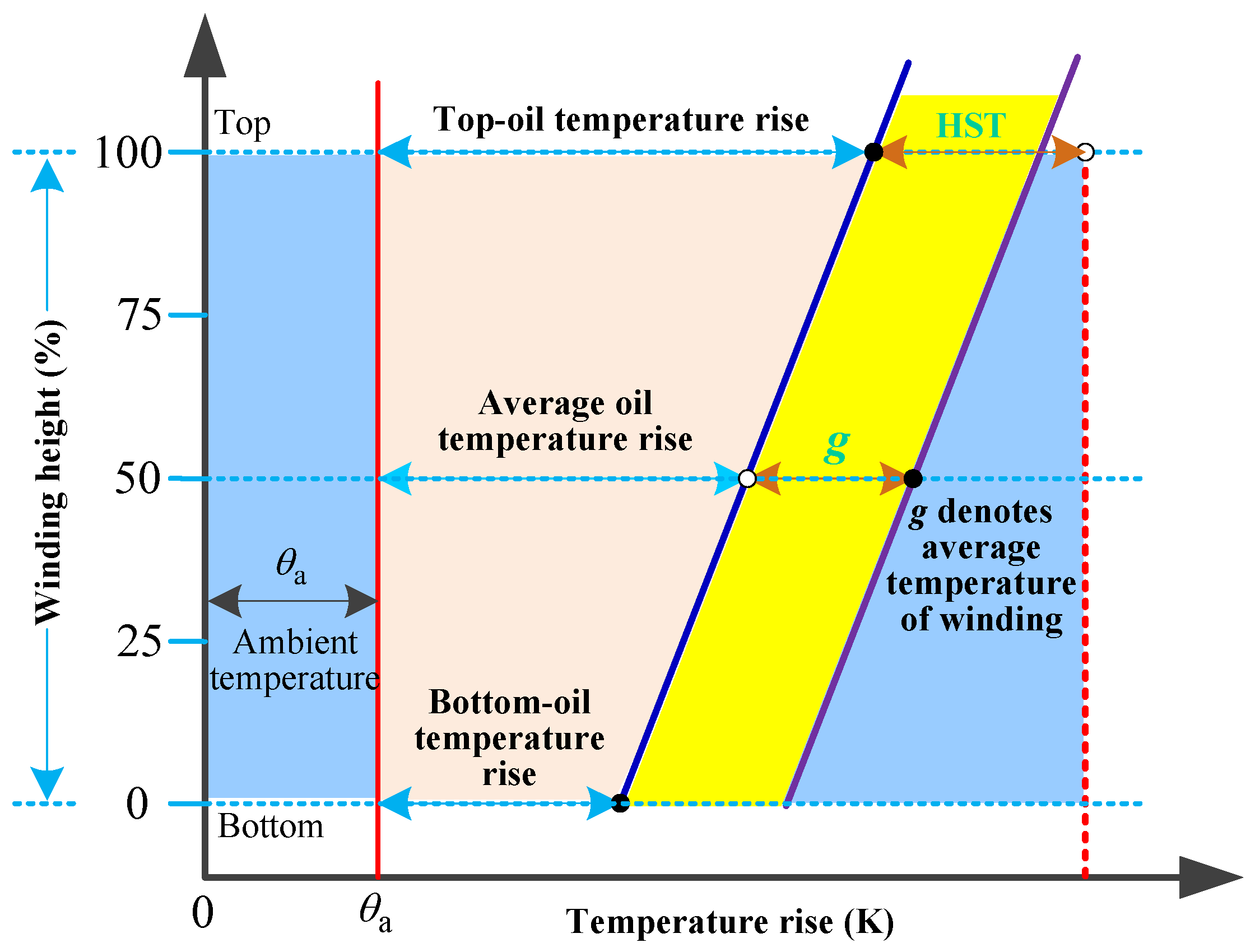

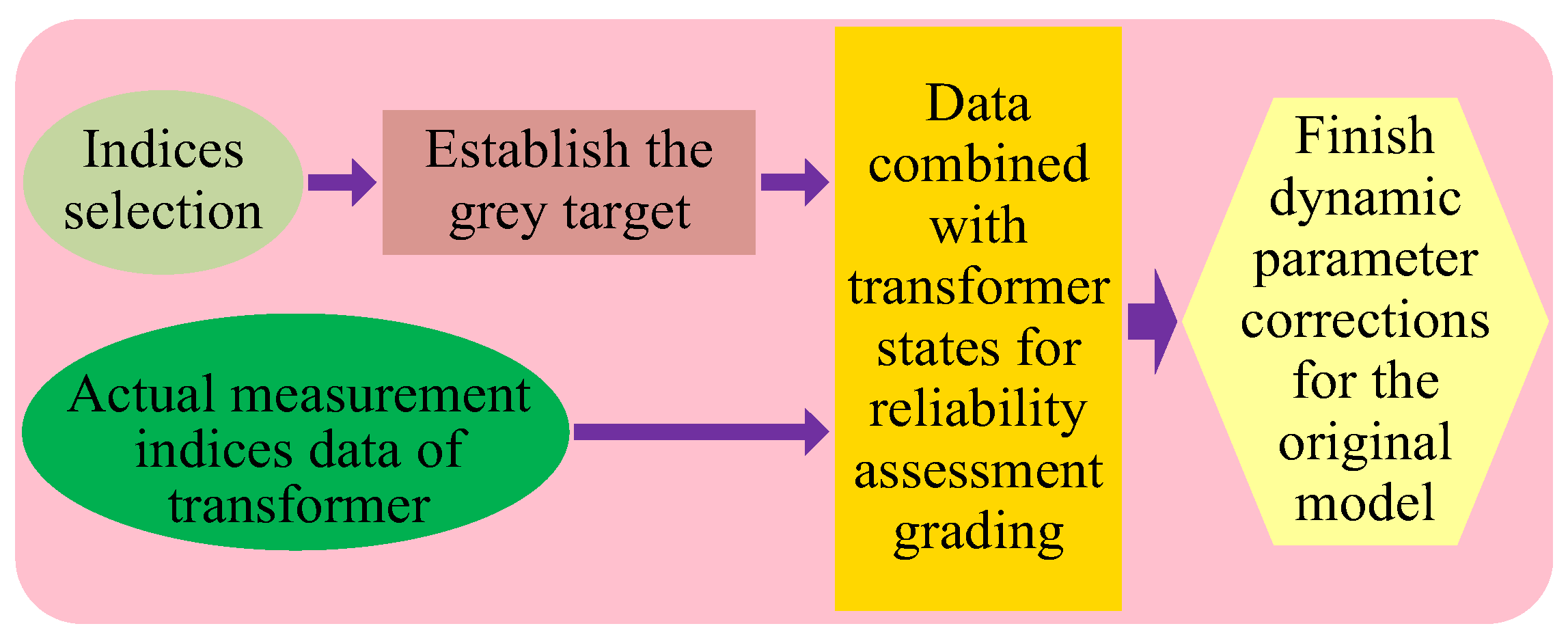
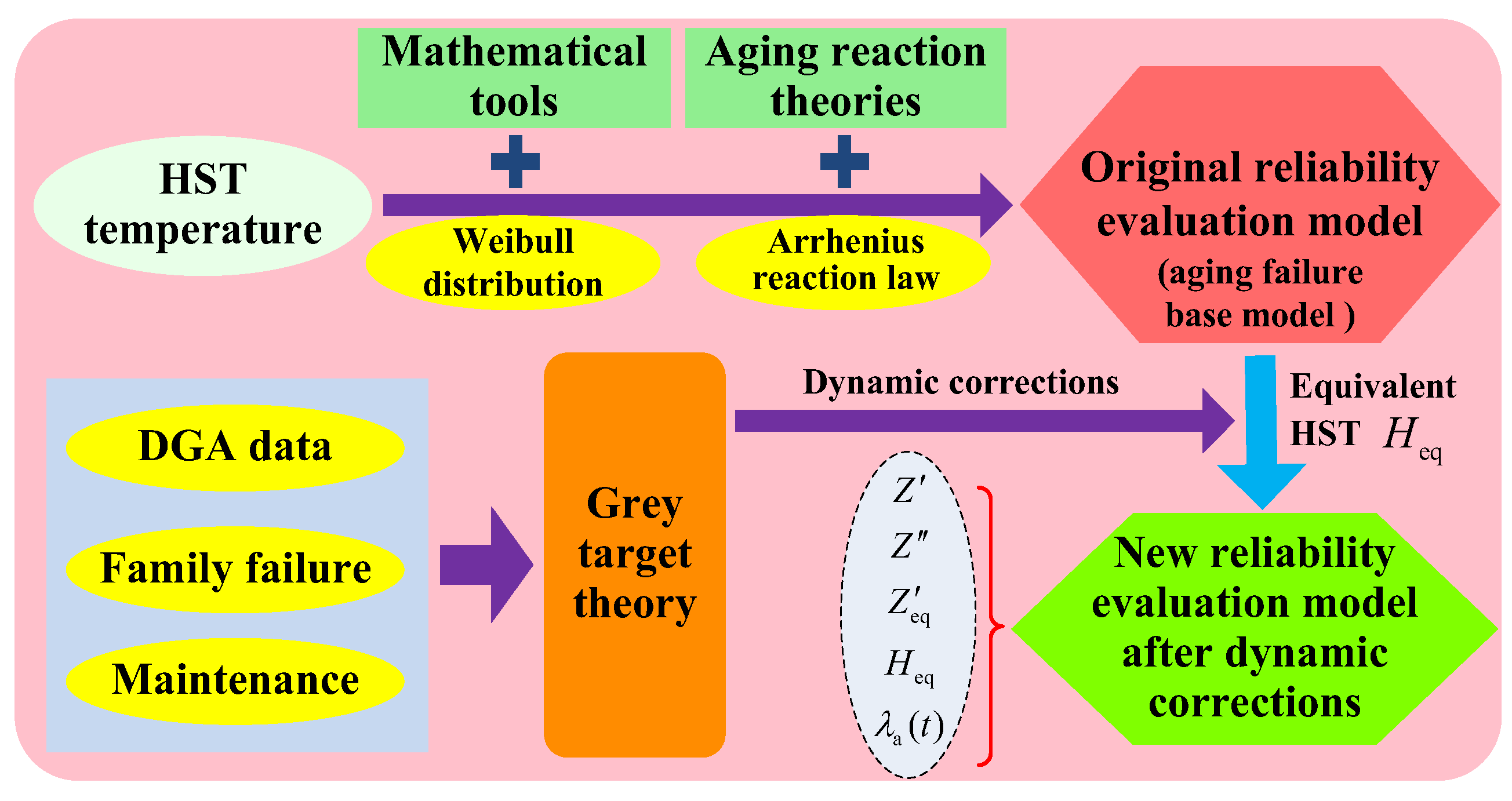
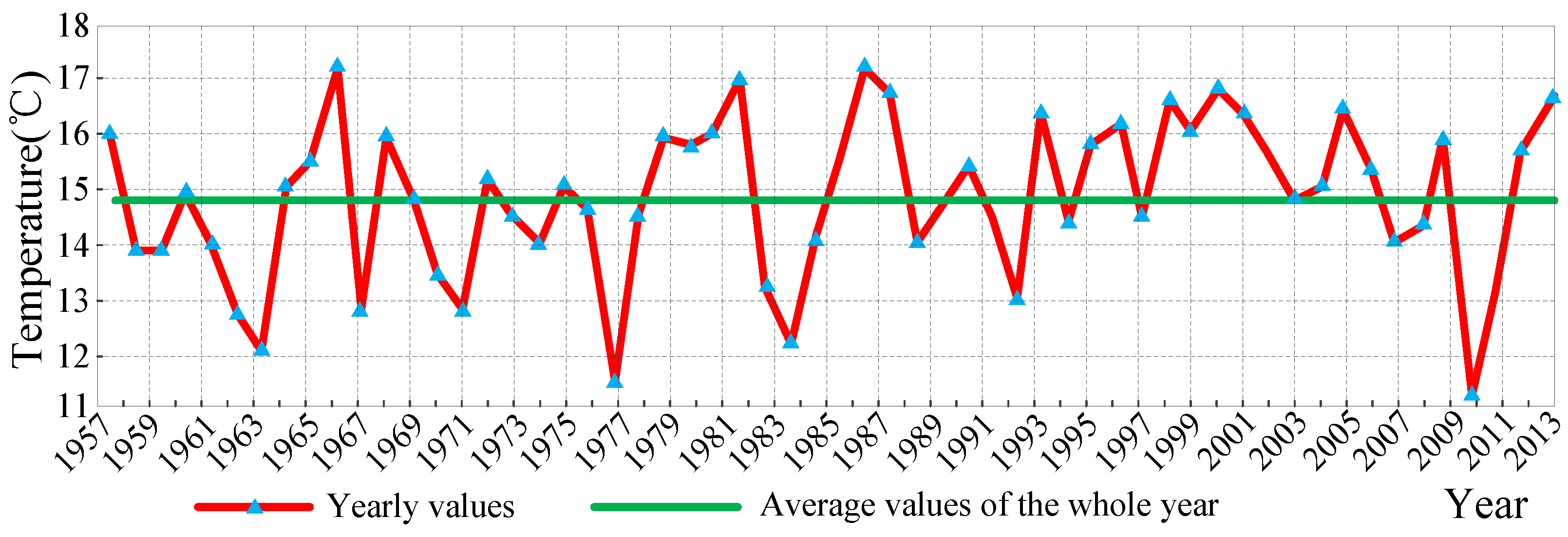
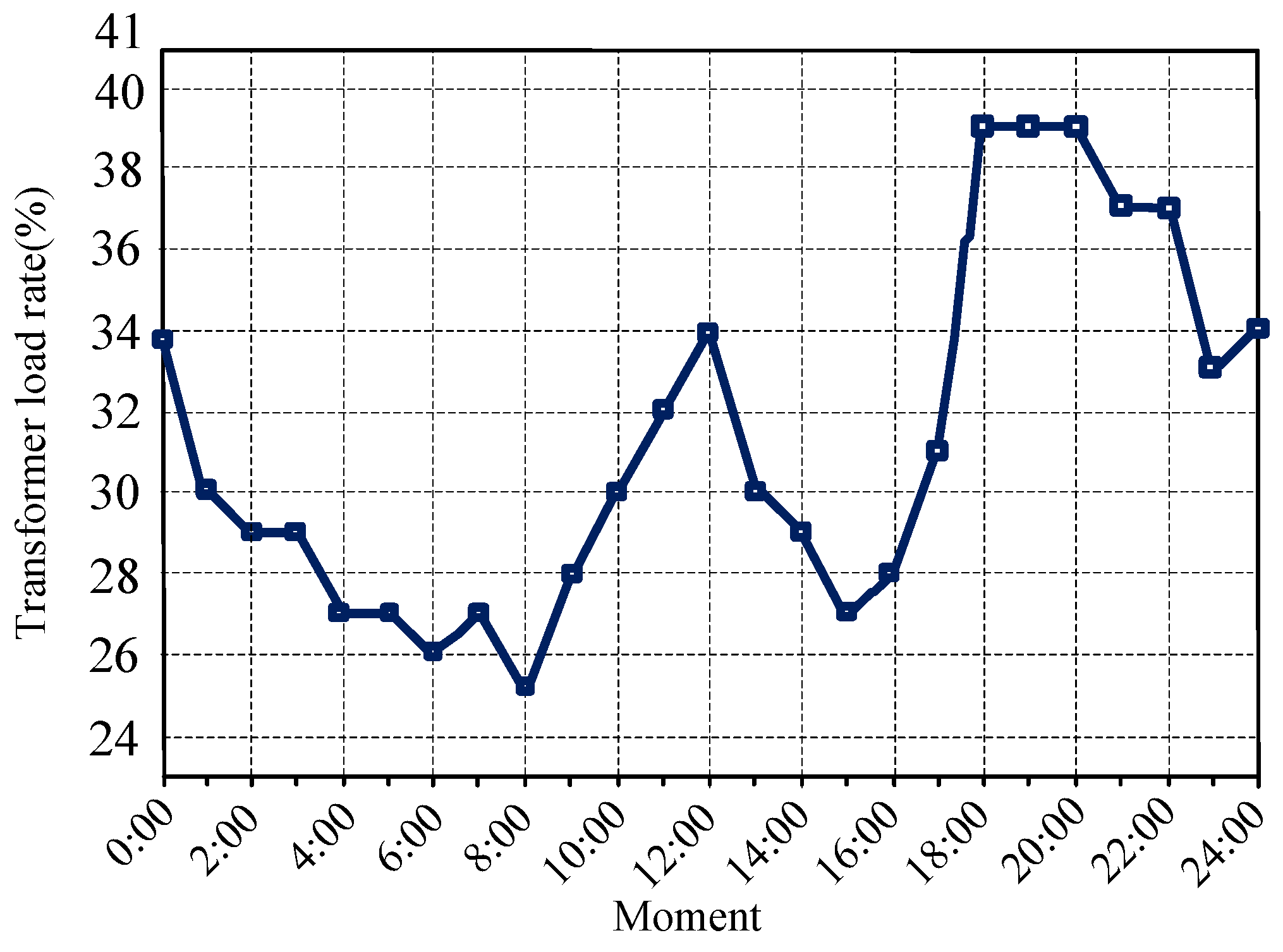
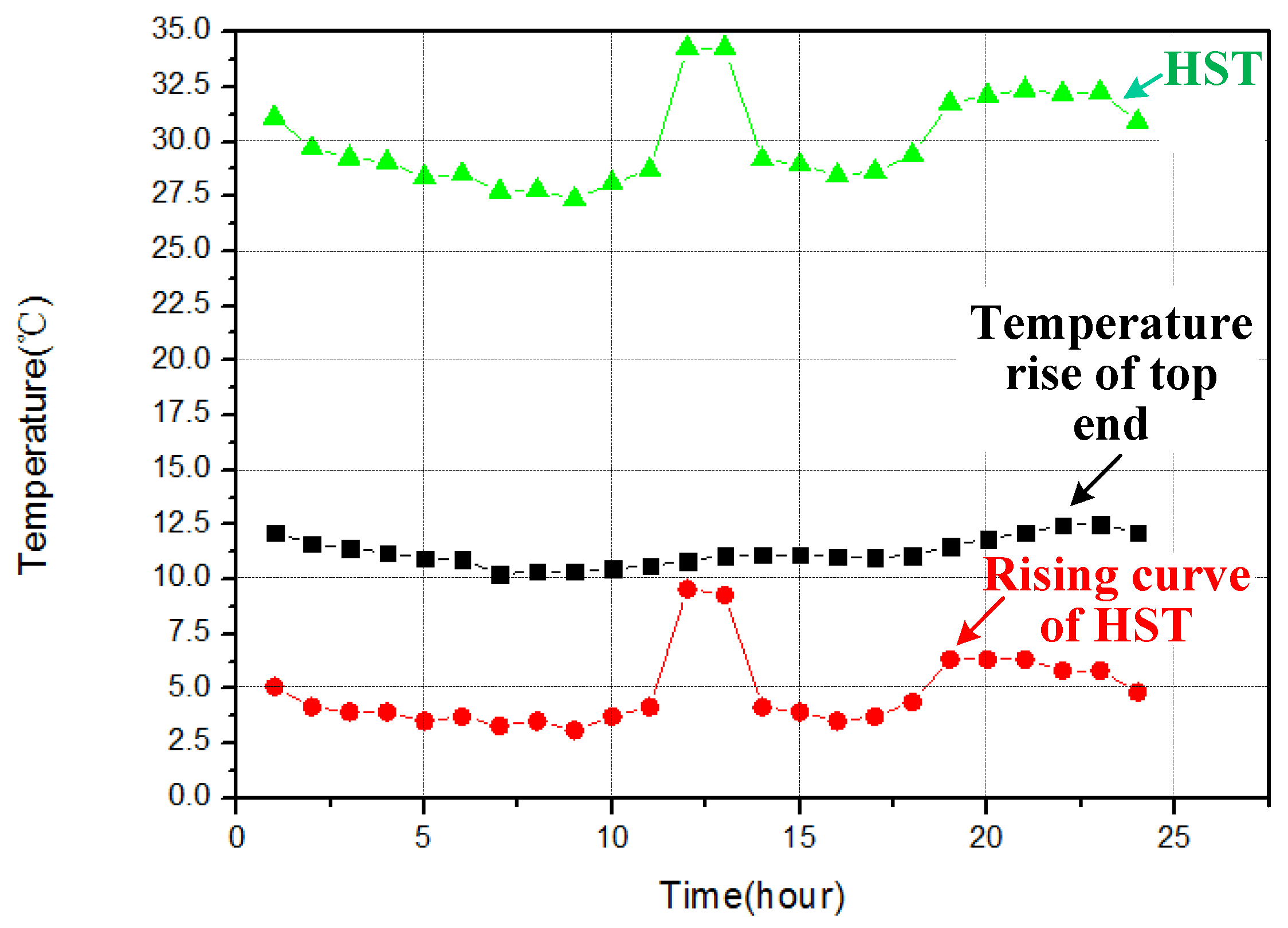


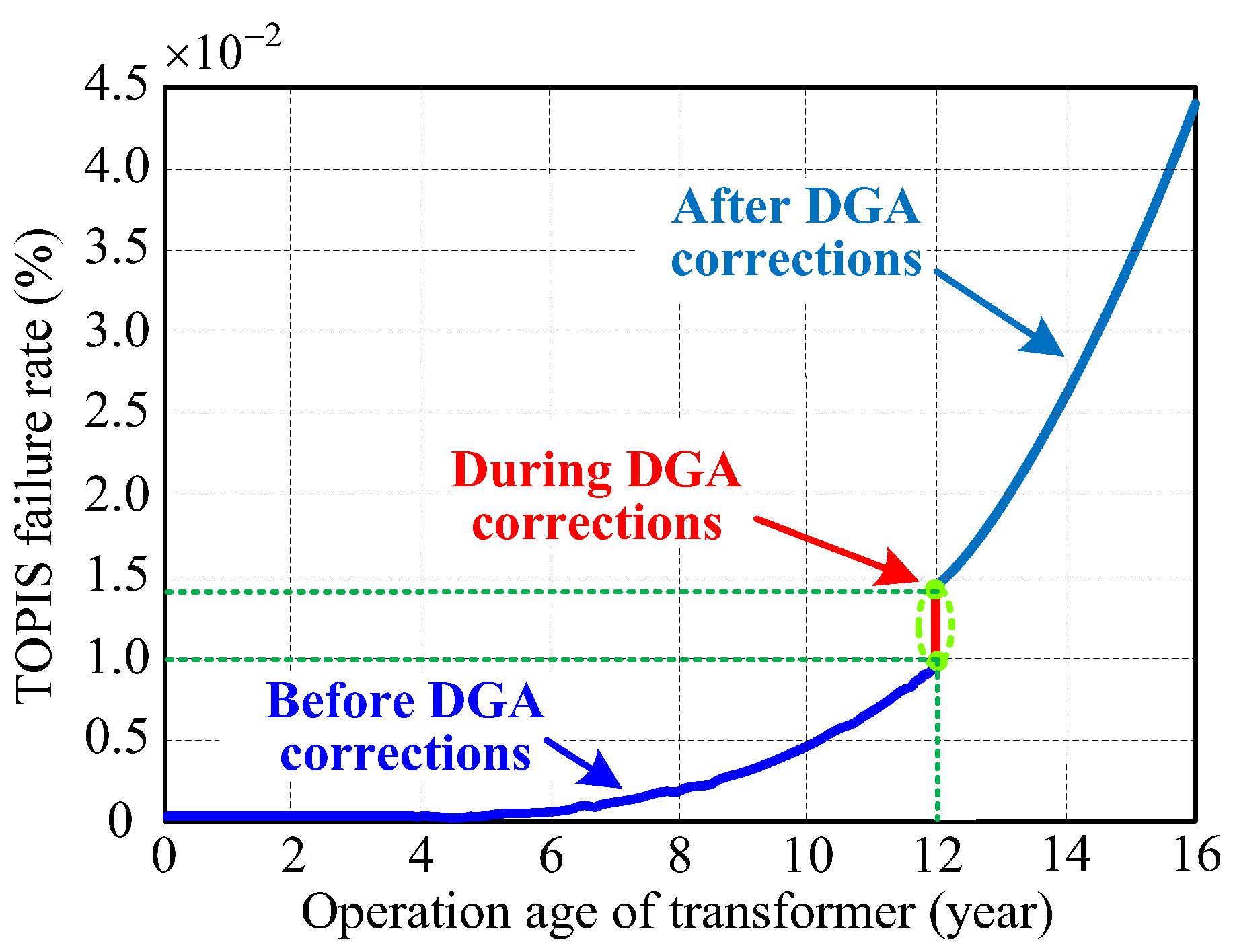

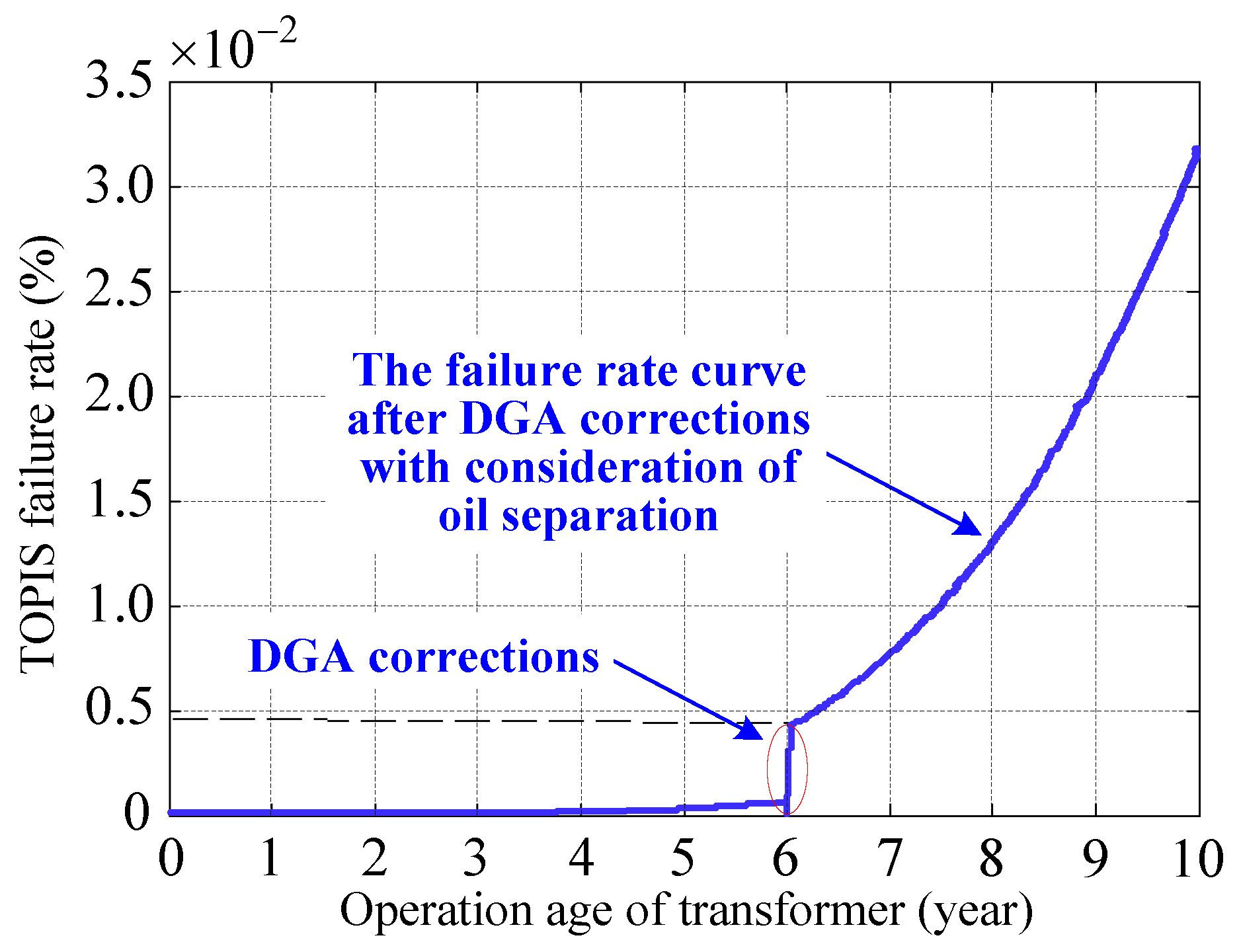
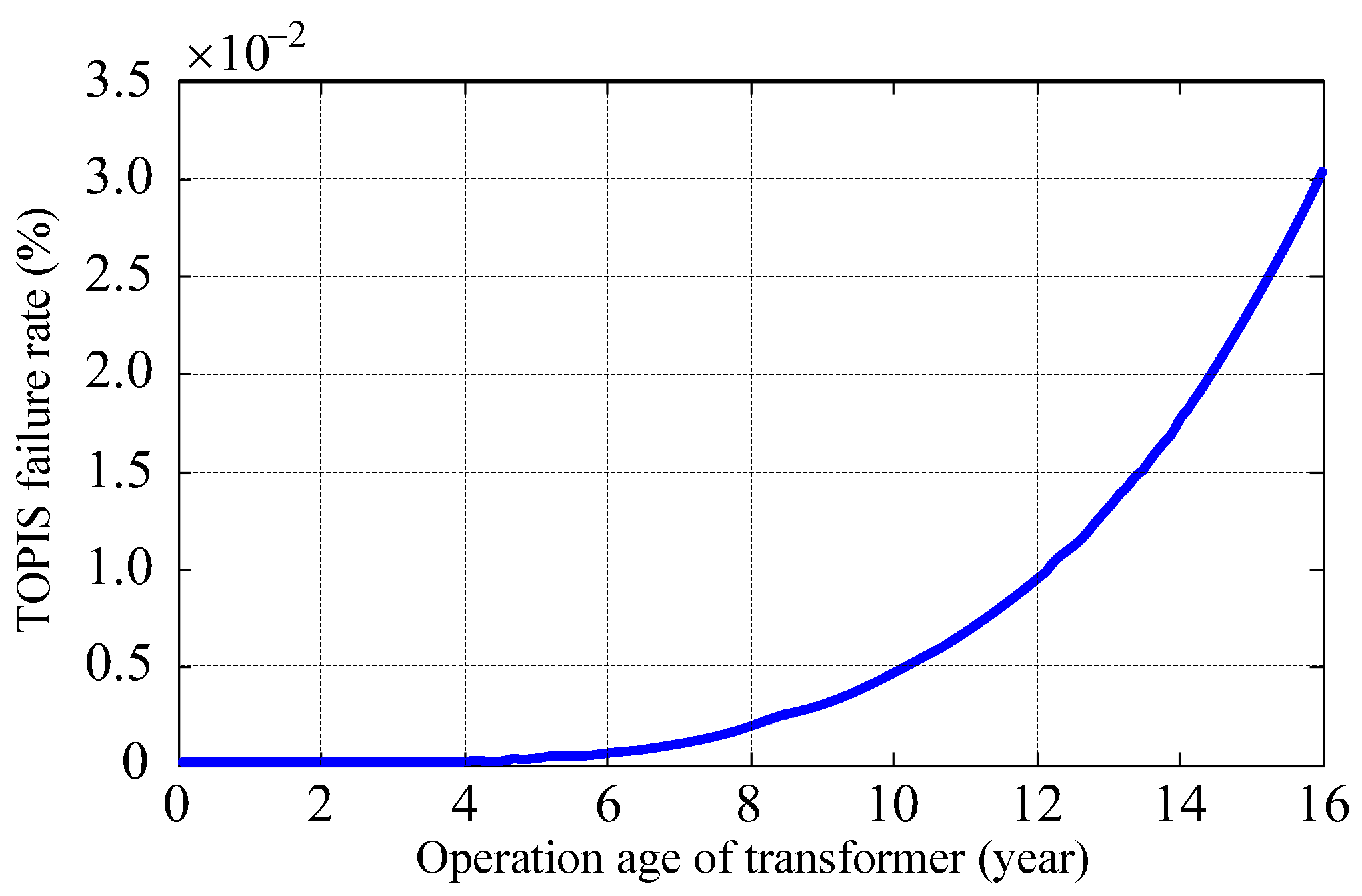
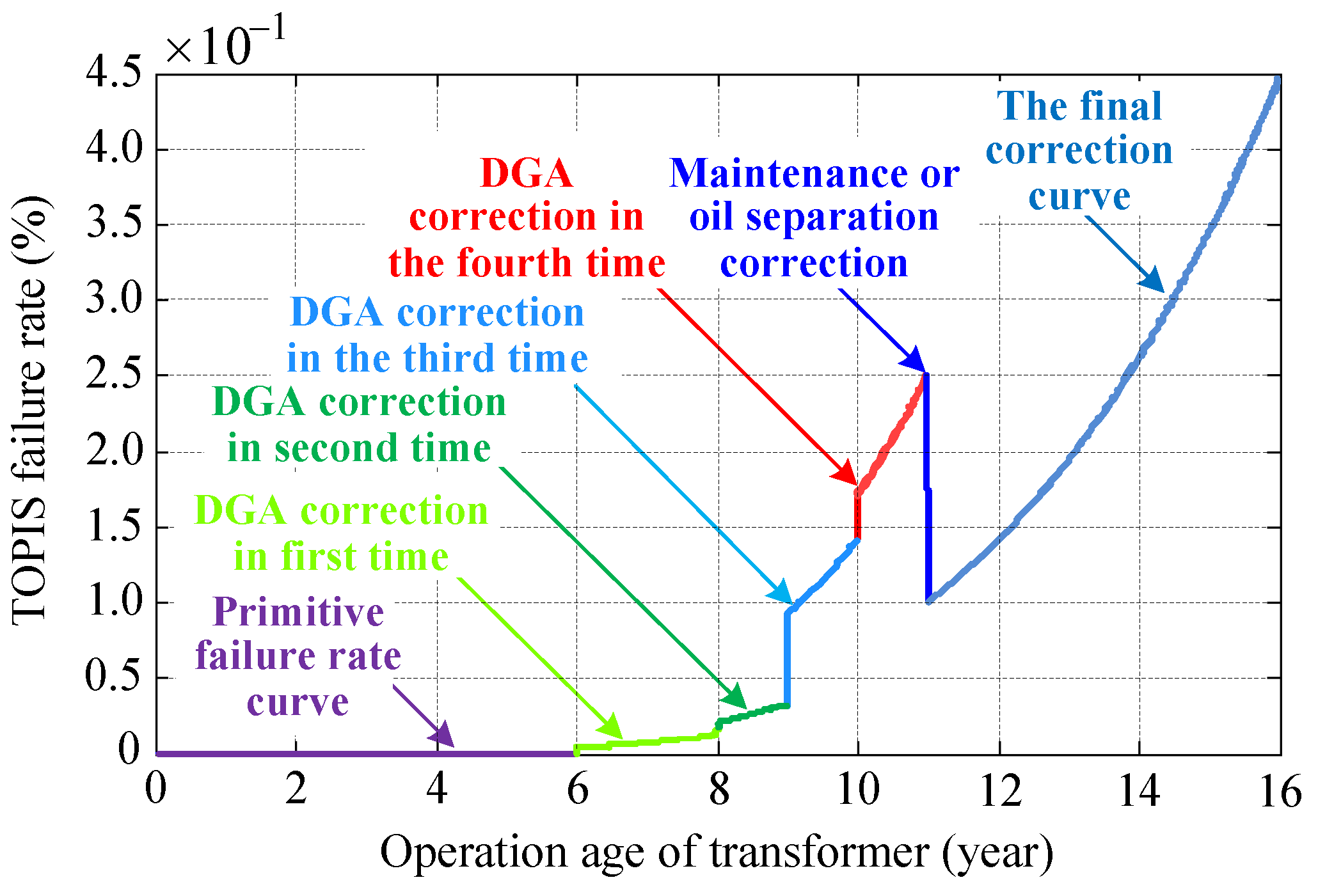
| Failures | Main Gas Components | Petit Gas Components |
|---|---|---|
| Oil overheating | CH4, C2H4 | H2, C2H6 |
| Oil and oil paper overheating | CH4, C2H4, CO, CO2 | H2, C2H6 |
| Partial discharge in TOPIS | H2, C2H2 | C2H2, C2H6, CO2 |
| Spark discharge in oil | H2, C2H2 | / |
| Electric arc in oil | H2, C2H2 | CH4, C2H4, C2H6 |
| Electric arc in oil and oil-paper | H2, C2H2, CO, CO2 | CH4, C2H4, C2H6 |
| Range of Approaching Degree Q | State Grade | Life Expectancy Correction Coefficient L |
|---|---|---|
| [[0.9,1.0] | Health state | [[0.85,1.00] |
| [0.6,0.9) | Normal state | [0.40,0.85) |
| [0.5,0.6) | Slight failure | [0.25,0.40) |
| [0.4,0.5) | Medium failure | [0.10,0.25) |
| [0.33,0.4) | Serious failure | [0,0.10) |
| Date (Year) | Gas Contents (μL/L) | ||||
|---|---|---|---|---|---|
| H2 | CH4 | C2H6 | C2H4 | C2H2 | |
| 2002 | 3 | 1.2 | 1 | 0 | 0 |
| 2003 | 6 | 3.2 | 0 | 2.1 | 0 |
| 2004 | 7 | 5.49 | 0.85 | 3.03 | 0 |
| 2005 | 4 | 6.22 | 0.99 | 3.1 | 0 |
| 2006 | 4 | 8.53 | 1.24 | 3.49 | 0 |
| 2007 | 4 | 10.25 | 1.63 | 4.16 | 0 |
| 2008 | 3 | 11.7 | 1.8 | 4.14 | 0 |
| 2009 | 3 | 11.66 | 1.79 | 4.14 | 0 |
| 2010 | 2 | 14.86 | 2.09 | 3.81 | 0 |
| 2011 | 3 | 13.02 | 1.84 | 3.14 | 0 |
| 2012 | 3 | 13.8 | 2.06 | 3.2 | 0 |
| 2013 | 0 | 19.72 | 3.06 | 3.65 | 0 |
| 2014 | 0 | 18.82 | 3.08 | 3.53 | 0 |
| Operation Time(Year) | Maintenance Circumstances | Characteristic Gas Contents (μL/L) | ||||
|---|---|---|---|---|---|---|
| H2 | CH4 | C2H6 | C2H4 | C2H2 | ||
| 5 | Before maintenance | 25.8 | 15.5 | 6.38 | 20.54 | 0 |
| 6 | During maintenance | 66 | 8.27 | 8.21 | 9.21 | 8.21 |
| 7 | After maintenance | 0 | 0.81 | 0 | 0.12 | 0 |
© 2018 by the authors. Licensee MDPI, Basel, Switzerland. This article is an open access article distributed under the terms and conditions of the Creative Commons Attribution (CC BY) license (http://creativecommons.org/licenses/by/4.0/).
Share and Cite
Cheng, L.; Yu, T.; Wang, G.; Yang, B.; Zhou, L. Hot Spot Temperature and Grey Target Theory-Based Dynamic Modelling for Reliability Assessment of Transformer Oil-Paper Insulation Systems: A Practical Case Study. Energies 2018, 11, 249. https://doi.org/10.3390/en11010249
Cheng L, Yu T, Wang G, Yang B, Zhou L. Hot Spot Temperature and Grey Target Theory-Based Dynamic Modelling for Reliability Assessment of Transformer Oil-Paper Insulation Systems: A Practical Case Study. Energies. 2018; 11(1):249. https://doi.org/10.3390/en11010249
Chicago/Turabian StyleCheng, Lefeng, Tao Yu, Guoping Wang, Bo Yang, and Lv Zhou. 2018. "Hot Spot Temperature and Grey Target Theory-Based Dynamic Modelling for Reliability Assessment of Transformer Oil-Paper Insulation Systems: A Practical Case Study" Energies 11, no. 1: 249. https://doi.org/10.3390/en11010249






